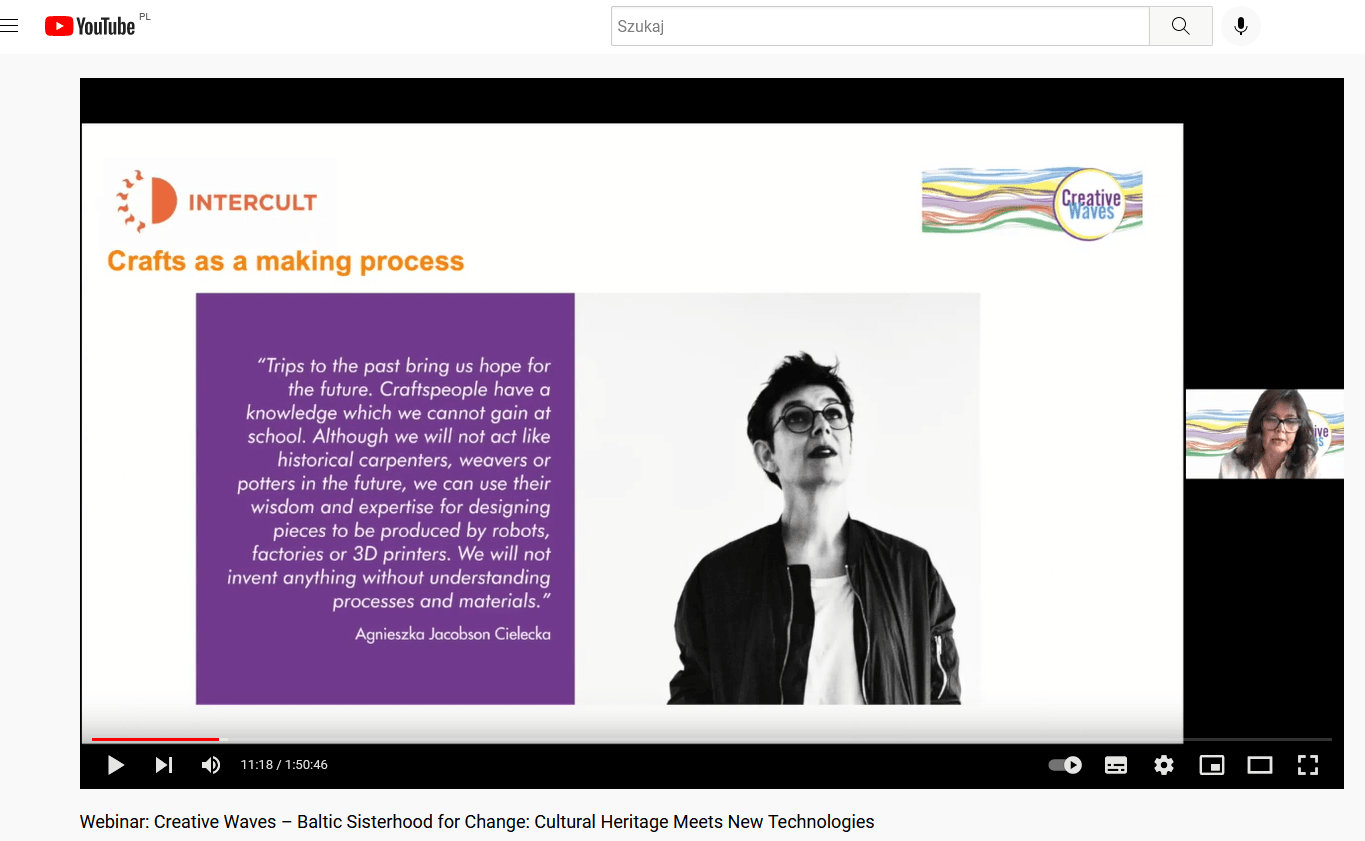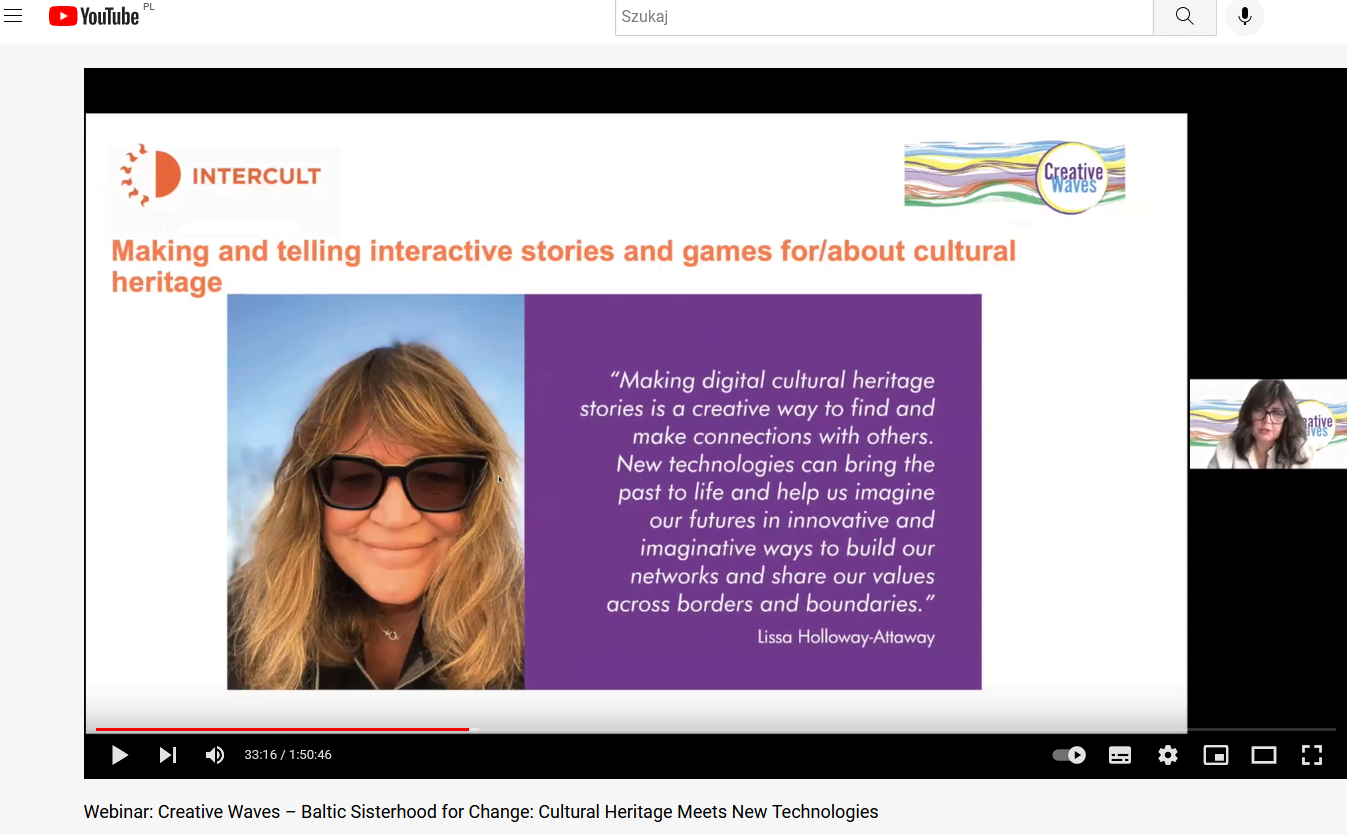“Embroidering is not just about embroidery and cooking is not just about a tasty dish. These used to be social activities which helped build social relations and the feeling of sisterhood”
Craft and digital language, tradition and new technologies – the international project “Creative Waves” combines and tames them, working to increase the visibility of creative women. On 28th Februrary the project carried out an international webinar on combining cultural heritage with new technologies.
The aim of “Creative Waves” is to create a physical and virtual space where creative women can meet and exchange experiences, thus building strength and gaining self-confidence. Our activities are directed primarily to women whose interests are related to the sphere of tradition and craftsmanship.
The participants of the webbinar had a chance to listen to the presentations
of two renowned speakers: dr Agnieszka Jacobson-Cielecka (independent critic and curator of design, co-author of the curriculum at the School of Form, SWPS) and dr Lissy Halloway-Attaway (associate professor of Media Art, Aesthetics and Narration at the University of Skovde in Sweden).
Agnieszka Cielecka-Jacobson and Lissa Holloway-Attaway shared their knowledge on combining heritage, especially intangible heritage, with new technologies from the perspective of current trends and scientific research. They illustrated their speeches with specific examples of activities and projects from different parts of the world.
dr Agnieszka Cielecka-Jacobson: link

dr Lissa Holloway-Attaway: link

Below you will find a summary of the most important theses that appeared in the presentations of the experts.
The most important theses of the speech entitled “Crafts as a creation process”:
- common denominator of the Baltic Sea – common views, landscapes, colors of the surroundings, professions, crafts and materials result in a surprisingly unified aesthetics, similar patterns in crafts, artistic expressions etc.
- by using available technologies, we can better understand materials and processes, which will help us keep disappearing crafts
- Traveling in the past gives us hope for the future: craftsmen have significant knowledge that we can use to design elements produced by robots, factories or 3D printers
- a few examples of how to be creative and create artistic products, while facing current problems, incl. how to deal with plastic waste:
– lamp PET project: lamps made of PET bottles by local people in different parts of the planet. Local women recycle their waste using traditional artisanal methods and patterns, keeping them busy and earning money. As a result, activities become more entrepreneurial and gain more confidence as their products gain popularity.
– teaching robots traditional handcraft – Teaching robots of traditional craftsmanship – weaving socks, embroidering, weaving baskets – results in bringing old traditions and crafts back to life and a better understanding of materials.
- design it’s a language which we can use to promote suistainable development, cooperation, creativity and innovation; it can become a connecting element between people
- craft as a language that is not based on education or nationality
The purpose of technology is not to replace the work of artisans – but to support it.
The most important theses of the speech entitled “Creating and telling interactive stories and games for cultural heritage and cultural heritage”:
- “It is important what stories make worlds and what worlds make stories ”- the materials we use to tell our stories are the frames that define the way we tell. This framework changes with the nature of our material involvement.
- when telling stories, we focus on materials – the materials we use affect the stories we tell; we move between them
- we live in troubled times of the Anthropocene – the effects of human influence on the world are disturbing, which is related to the way stories are told. To change the way we influence the world, we must re-learn to tell stories. We have to rethink the new media.
- “Tentacle” creativity – when telling a story, it is worth being inspired by the multisensory tentacles of octopuses that collect information about taste, touch, smell, etc. In the story, we should use all ways of understanding the world – it is about multi-sensory, multi-directional material experiences. The tentacle approach can be useful in transforming traditional handicrafts. tentacles
- storytelling about heritage through technology, e.g. through new spaces and museums
- combining technologies (computers, digital design tools, AR / VR, AI, programming, software, platforms) and the area of arts and humanities (crafts, literature, performing arts, art, history, graphics, sound / music, video / photography, studies socio-cultural), as an opportunity to create a new way of talking about cultural heritage in schools, museums, art galleries and at exhibitions or online platforms
- new technologies: when we use Augmented Reality, all users are artists; transmedia, or how to tell stories on multiple platforms; MR (Mixed Reality) as an encounter between physical and visual reality
- co-creation can take place through participation. Co-created projects give voice to local communities and respond to their needs. At the same time, they provide space for community involvement and dialogue, and help participants develop skills that support their individual and social goals
- post-digital era – instead of thinking about the possibilities of using new technologies, we should focus on the content conveyed by using digital technologies and solutions, we build awareness of intangible cultural heritage – including micro-heritage
- by using digital technologies such as games, we encourage you to read books and visit museums and discover local stories
- to help people learn about tangible and intangible heritage, we can encourage them to play board games – keep telling the same stories through different media
- new technologies help us to understand what heritage is and what heritage we have in a given area. Their use increases the ability to think conceptually
- the need to develop intergenerational connections – it is worth considering what technologies are needed for this
- combining intangible cultural heritage and new technologies can provide residents with new business opportunities
The full webbinar recording: link
